Released in select US cinemas last week, A Glimpse Inside the Mind of Charles Swan III has no scheduled UK release date as of yet. This reviewer saw it on demand as a rental from the iTunes US store. In order to access the store, you must have a US iTunes account.
Charles Swan is a man who wants everything he can't have, and that's everyone when it comes to women. A drug-addled, sad-sack sex addict with a Ron Jeremy paunch to match, Charlie Sheen totters right out of the real life web pages of TMZ and straight into Roman Coppola's dollhouse recreation of a Wes Anderson set. The film's seventies setting and curio costuming of Jason Schwartzman's Kirby, first seen in tennis gear, is also a blatant riff on Richie Tenenbaum. Coppola mimicked that film's visual style using the same cinematographer Robert Yeoman on his first film, but in the years since, the Anderson influence is manifold, not least because the two were co-screenwriters on The Darjeeling Limited and Moonrise Kingdom.
Despite having the Coppola surname, Roman hasn't directed a feature in the twelve years since CQ, a light on its feet conglomeration of Nouvelle Vague references and obsessively recreated sixties sci-fi interiors staring Jeremy Davis, that for all its camp, also managed to cram in a not-so-formal disquisition on artists trapped between making heartfelt, personal art nobody wants to see and commercial product they can't put their hearts into.
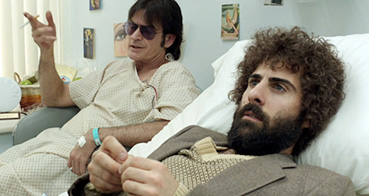
In the case of CQ, nobody in the UK ever got as far as deciding if they wanted to see it, as the film was never theatrically released and bypassed DVD altogether. Whenever I slip it into conversations about why a dividing line exists between Wes Anderson's first four pictures and the somewhat diminished, recycled quality of his subsequent output, or whether we can seriously start considering Sofia Coppola to be a better filmmaker than her father, most have never even heard of CQ, let alone seen it. More than likely, the follow up will meet a similar end with a tiny US release and no UK dates yet on the calendar.
It's only for those in the know (or who care to remember), that more than a decade later, A Glimpse Inside the Mind of Charles Swan III, might be considered something of a comeback film. If so this is not for any distinguishing qualities, other than Coppola finally managing to find his way behind a megaphone again. For fans of CQ, Charles Swan will feel so familiar it's as if the last twelve years never happened.
Continuing CQ's exploration of men failing to be the best they can be personally and professionally, Swan, like its predecessor, is also stuffed to the gills with visual bric-a-brac and finds Coppola once more emulating Godard and the seventies films he grew up on.
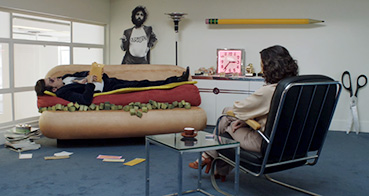
For the film's star Charlie Sheen, it's not the much-needed image rehabilitation you might expect either. Doing little to remind us that he was once a viable dramatic and comedic actor, Sheen's unglued tabloid persona is still very much in evidence. Hiding the night before behind tinted shades, Charles Swan III is a renowned graphic designer in emotional free-fall. Though loosely based on album cover artist Charles White III, Sheen's own prima donna Kardashian-style behaviour and his social media spouts of rubber room crazy talk are obviously the principal source of inspiration here.
Coppola has fun with and pokes fun at the boyhood friend he met on the set of Apocalypse Now, and the very public meltdown that Sheen has now seemingly cultivated into his fulltime personality. Indeed, much of the film's humour and sadness comes from the fact that Sheen doesn't appear to be in on the joke at all. The star's hungover, at times near comatose performance is a black circle celebration of debauchery and excess that spins often and fast enough to make the viewer reflect - almost by accident - upon the strife of those struggling to define themselves outside their abysmal addictions.
The litmus test for the audience and the film's own idea of fun, is in the charmed hopelessness of Charles' condition, which makes eighty-six freewheeling minutes spent in his company feel like the ups and downs of hanging out at a rehab meeting with Axl Rose, Hank Moody, George Jung… and well, Charlie Sheen.
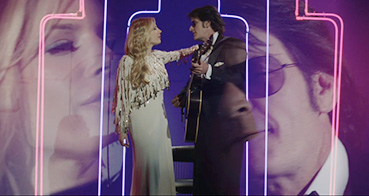
Certainly the actor is playing to his current strengths then, as a shameless asshole who everybody knows is past his prime but him. Slowly starting to figure out that people see him as an unlikeable wash-up and not a lovable rascal, over the course of the film, the fuzzy line between character and actor seems to disappear altogether and suddenly you feel as though you're watching Sheen painfully come to terms with his recent career downturn on screen.
If that interpretation is too meta for you, the opening scenes beat the viewer over the head with the idea that Charles (thinly veiled avatar or not), is a loser whose life is in the toilet and doesn't know how to hit bottom. Reversing his car down a cliff into a homeowner's pool is just the start of his day.
Our hyperbolic hypochondriac just can't seem to get over his one true lay, bit-of-fluff actress Ivana (Katheryn Winnick), who walks out on Charles after discovering every notch on his bedpost as a sleazy polaroid snapshot hidden none-too-cleverly in the same drawer where he keeps his only picture of the two of them.
The stash of filthy photos is but the tip of the iceberg. A title sequence shows Charles' brain as an exploding pop art attack of pin-up girl pins, boobs and backsides. With all those legs and bare breasts, there's barely enough room for thoughts of his best friend Kirby and sister Izzy (Patricia Arquette).
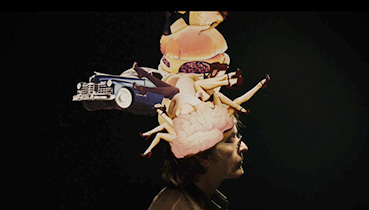
Charles' baser instincts are channeled but never vented in his continual book covers of big titty women, and on the rare occasion he's able to pull his head out of a pair of gazongas (figurative or otherwise), he's barely able to whip together uninspired album covers of singer-songwiter wannabes with a David Bowie complex.
Stepping off the 'bang bus' parked right outside his office and riding around looking for his next screw in a Cadillac with giant bacon and eggs painted on each door, Charles makes it horn-honkingly clear he likes his women sizzling hot and their assets big and fluffy.
Pulled between agony and ecstasy, the leathery lothario, exists in a constant state of coitus interruptus. No sooner has he bedded himself a bombshell, than Charles' fantasies turn out to be anything but sexual. To one conquest he re-enacts a recurring dream of saving a women by easily overpowering her attacker. Of course the forever-grateful dame then willingly throws herself at him. Misconceiving his chauvinism for chivalry and unable to face up to the fact that he is in fact a sexist, misogynistic pig, harsh reality is likewise cottoned in fantasy. The film's most wonderfully extravagant abstraction has him winning the 'Best Bullshit' award from the Academy of Sexy Women. Laying out another line of bullshit at the podium, he lives out his fanciful dream of people finding his fabrications fabulous and fascinating.
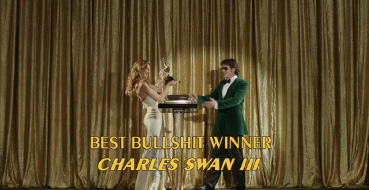
A fully staged death fantasy in which the women find themselves gathered around the asshole's grave, dares to suggest that Charles may even be missed. Stronger than death, Charles then rises from the earth, making his many lovers fall in love with him all over again, busting out musical moves all over the cemetery. The impromptu glitz of the genre temporarily puts some razzle-dazzle on the degradation trip which is life – at least until he's seen dancing atop a tomb covered in dust, which in medium shot looks like he's toe-tapping through a long line of coke.
A psychodrama with reality the needle in fantasy's haystack, Charles is able to see himself as ennobled and suave instead of desperate and sad. In the gilded playback of his overactive imagination, women are the cause of all his problems and solely to blame. Far from making him insufferable, his constant whining about them is entirely justified given that Charles plays his woes using an entire orchestra over the world's smallest violin (I'm sure there's even a scene of Charles doing exactly that and conducting a symphony, though I can't say for certain).
Kaleidoscoping purposely-misremembered memories with the ridiculousness of entirely false lucid dreams, there's a kineticism to the narrative, mercilessly pulled along behind and advanced by its absurd action sequences. One such nugget of deadpan deliciousness finds Charles and Kirby decked out in cowboy gear, riding horses against a projected backdrop, only to find themselves seconds later, on-location and outnumbered by half-naked hotties dressed as Indians, a honey trap from which they're saved by none other than Bill Murray as John Wayne.
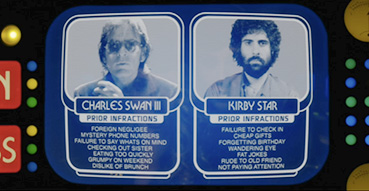
In another bit of blithe nonsense, the boys find themselves pursued by The Secret Society of Ball-Busters, imagined as a Barberella-esque underground compound with a network of surveillance equipment that hones in on their every flirtation. In memorable cameos we have Smashed's Mary Elizabeth Winstead and CQ star Angela Lindval. Dressed up as smoking hot women of the SS, they've got garter belts, guns and special sonar for detecting chat-up lines. As Charles and Kirby are hitting on waitresses and getting phone numbers, rockets are launched on their location and Bill Murray is there once again to save them in the nick of time, just as the restaurant explodes and a Garth Marenghi-style car chase ensues with a chopper in pursuit.
A film of variable speed and kitsch, there's not a moment where A Glimpse Inside the Mind of Charles Swan III doesn't pop with colourful costumes and pizazz production design. Offbeat items such as a couch in the shape of a giant hotdog constitute the peculiarity of its very life force.
Charles confusing heartburn for a heart attack is indicative of the psychological depth of this particular head-trip, but as a mindbending odyssey of the surreal it's certainly worth more than a glimpse.
|